2013 PEUGEOT 5008 headlamp
[x] Cancel search: headlampPage 4 of 364
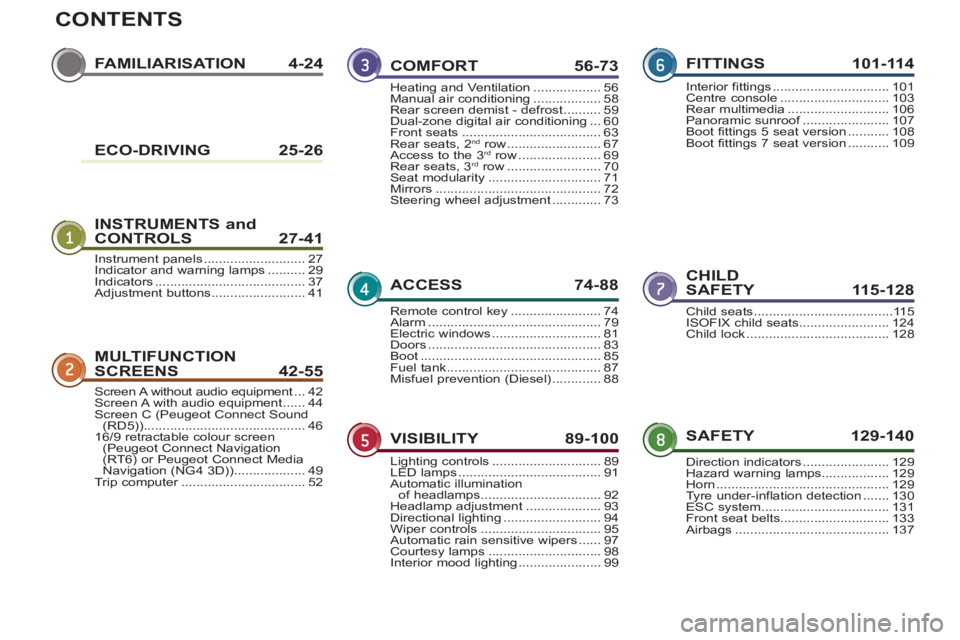
CONTENTS
FAMILIARISATION4-24
INSTRUMENTS and
CONTROLS 27-41
CHILD
SAFETY 115-128
MULTIFUNCTION
SCREEN
S42-55
SAFETY 129-140 COMFORT 56-7
3
ACCESS 74-88
VISIBILITY 89-100
FITTINGS 101-114
Instrument panels ...........................27Indicator and warning lamps ..........29Indicators........................................37Adjustment buttons.........................41
Child seats.....................................115ISOFIX child seats........................124Child lock......................................128
Screen A without audio equipment...t42Screen A with audio equipment......44Screen C (Peugeot Connect Sound (RD5))...........................................4616/9 retractable colour screen(Peugeot Connect Navigation (RT6) or Peugeot Connect Media
Navigation (NG4 3D))...................49Trip computer.................................r52
Direction indicators.......................129Hazard warning lamps..................129Horn..............................................129Tyre under-inflation detection .......130ESC system..................................131Front seat belts.............................133Airbags .........................................137
Heating and Ventilation ..................56Manual air conditioning ..................58Rear screen demist - defrost..........59Dual-zone digital air conditioning...60Front seats.....................................63Rear seats, 2nd row.........................67Access to the 3rdrow ......................69Rear seats, 3rdrow.........................70Seat modularity..............................71Mirrors............................................72Steering wheel adjustment .............73
Remote control key........................74Alarm..............................................79Electric windows.............................81Doors ..............................................83Boot................................................85Fuel tank.........................................87Misfuel prevention (Diesel).............88
Lighting controls.............................89LED lamps......................................91Automatic illumination
of headlamps................................92Headlamp adjustment ....................93Directional lighting..........................94Wiper controls................................95Automatic rain sensitive wipers ......97Courtesy lamps..............................98Interior mood lighting......................99
Interior fittings ...............................101Centre console .............................103Rear multimedia...........................106Panoramic sunroof.......................f107Boot fittings 5 seat version ...........108Boot fittings 7 seat version ...........109ECO-DRIVING 25-26
Page 8 of 364
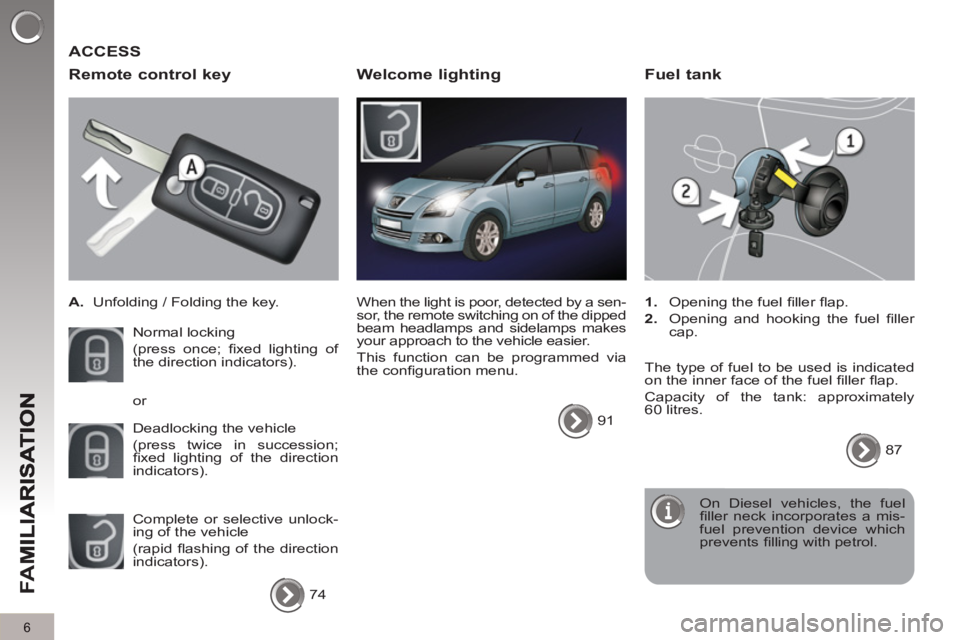
FA
M
6
ACCESS
Remote control ke
y
A.
Unfolding / Folding the key.
Normal locking
(press once; fi xed lighting of
the direction indicators).
Deadlocking the vehicle
(press twice in succession;
fi xed lighting of the direction
indicators).
Complete or selective unlock-
ing of the vehicle
(rapid fl ashing of the direction
indicators). or
74 When the light is poor, detected by a sen-
sor, the remote switching on of the dipped
beam headlamps and sidelamps makes
your approach to the vehicle easier.
This function can be programmed via
the confi guration menu.
91
87
Fuel tank
1.
Opening the fuel fi ller fl ap.
2.
Opening and hooking the fuel fi ller
cap.
The type of fuel to be used is indicated
on the inner face of the fuel fi ller fl ap.
Capacity of the tank: approximately
60 litres.
Welcome lighting
On Diesel vehicles, the fuel
fi ller neck incorporates a mis-
fuel prevention device which
prevents fi lling with petrol.
Page 11 of 364

FA
M
9
INSTRUMENTS AND CONTROLS
1.
Cruise control / speed limiter
switches.
2.
Steering wheel adjustment.
3.
Lighting and direction indicator
stalk.
4.
Instrument panel.
5.
Driver's airbag.
Horn.
6.
Gear lever.
7.
Electric parking brake.
8.
12 V accessories socket.
9.
Panoramic sunroof control.
10.
Owner's Handbook storage
compartment.
11 .
Bonnet release.
12.
Door mirror controls.
Electric window controls.
Child lock.
13.
Manual headlamp height adjustment.
14.
Alarm button.
Parking sensors button.
Dynamic stability control (ESC/
ASR) button.
Stop & Start.
15.
Front door window demist/defrost
vent.
16.
Windscreen demist/defrost vent.
Page 16 of 364
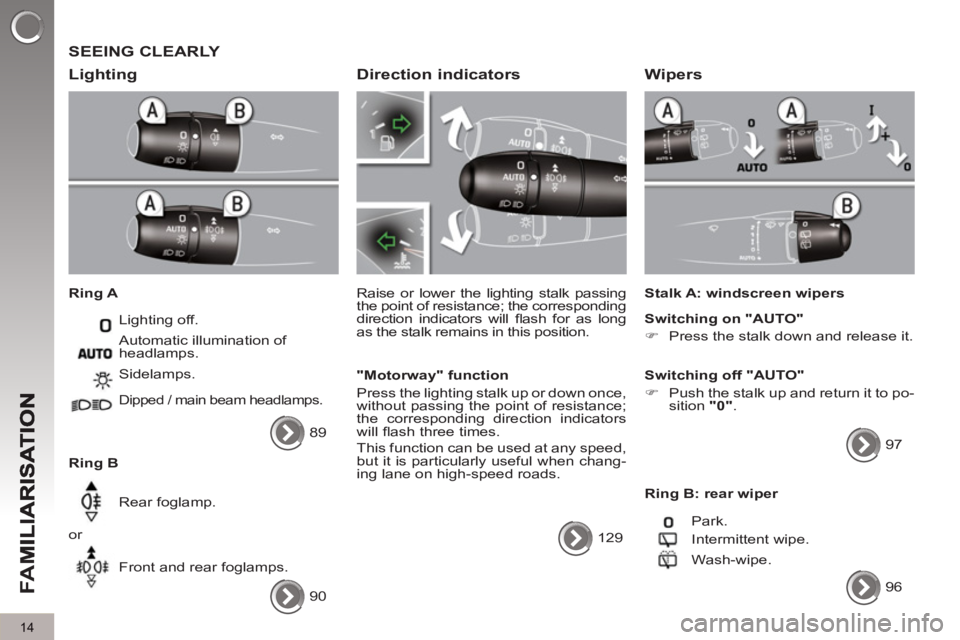
FA
M
14
SEEING CLEARLY
Li
ghting
Ring A
Lighting off.
Ring B Sidelamps.
Dipped / main beam headlamps.
Rear foglamp.
or
Front and rear foglamps. Automatic illumination of
headlamps.
90
Direction indicators
Raise or lower the lighting stalk passing
the point of resistance; the corresponding
direction indicators will fl ash for as long
as the stalk remains in this position.
"Motorway" function
Press the lighting stalk up or down once,
without passing the point of resistance;
the corresponding direction indicators
will fl ash three times.
This function can be used at any speed,
but it is particularly useful when chang-
ing lane on high-speed roads.
129
Wipers
Stalk A: windscreen wipers
Switching on "AUTO"
�)
Press the stalk down and release it.
Switching off "AUTO"
�)
Push the stalk up and return it to po-
sition "0"
.
97
Ring B: rear wiper
Park.
Intermittent wipe.
Wash-wipe.
96
89
Page 27 of 364
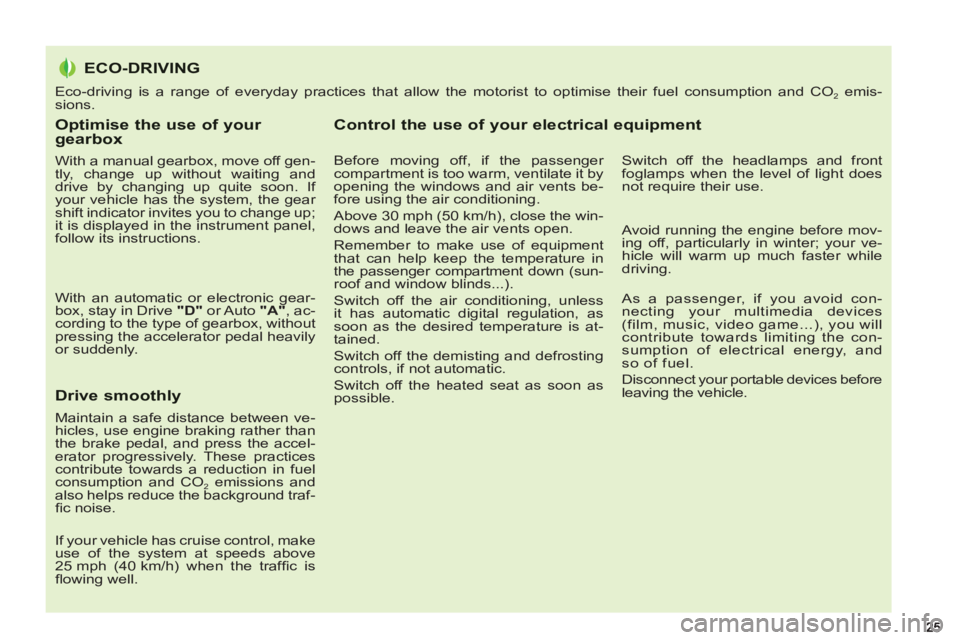
Optimise the use of your gearbox
With a manual gearbox, move off gen-
tly, change up without waiting and
drive by changing up quite soon. If
your vehicle has the system, the gear
shift indicator invites you to change up;
it is displayed in the instrument panel,
follow its instructions.
With an automatic or electronic gear-
box, stay in Drive "D"
or Auto "A"
, ac-
cording to the type of gearbox, without
pressing the accelerator pedal heavily
or suddenly.
Drive smoothly
Maintain a safe distance between ve-
hicles, use engine braking rather than
the brake pedal, and press the accel-
erator progressively. These practices
contribute towards a reduction in fuel
consumption and CO
2 emissions and
also helps reduce the background traf-
fi c noise.
If your vehicle has cruise control, make
use of the system at speeds above
25 mph (40 km/h) when the traffi c is
fl owing well.
Control the use of your electrical equipment
Before moving off, if the passenger
compartment is too warm, ventilate it by
opening the windows and air vents be-
fore using the air conditioning.
Above 30 mph (50 km/h), close the win-
dows and leave the air vents open.
Remember to make use of equipment
that can help keep the temperature in
the passenger compartment down (sun-roof and window blinds...).
Switch off the air conditioning, unless
it has automatic digital regulation, as
soon as the desired temperature is at-
tained.
Switch off the demisting and defrosting
controls, if not automatic.
Switch off the heated seat as soon as
possible.
Switch off the headlamps and front
foglamps when the level of light does
not require their use.
Avoid running the engine before mov-
ing off, particularly in winter; your ve-
hicle will warm up much faster while
driving.
As a passenger, if you avoid con-
necting your multimedia devices
(film, music, video game...), you will
contribute towards limiting the con-
sumption of electrical energy, and
so of fuel.
Disconnect your portable devices before
leaving the vehicle.
ECO-DRIVING
2525
Eco-driving is a range of everyday practices that allow the motorist to optimise their fuel consumption and CO2 emis-
sions.
Page 31 of 364
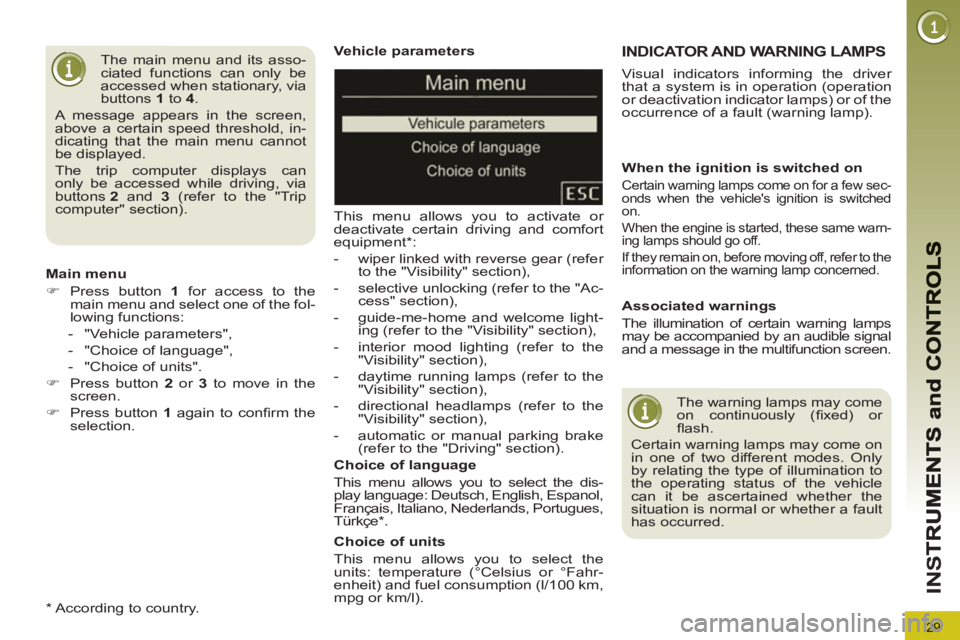
29
IN
S
Vehicle parameters
This menu allows you to activate or
deactivate certain driving and comfort
equipment * :
- wiper linked with reverse gear (refer
to the "Visibility" section),
- selective unlocking (refer to the "Ac-
cess" section),
- guide-me-home and welcome light-
ing (refer to the "Visibility" section),
- interior mood lighting (refer to the
"Visibility" section),
- daytime running lamps (refer to the
"Visibility" section),
- directional headlamps (refer to the
"Visibility" section),
- automatic or manual parking brake
(refer to the "Driving" section).
Choice of units
This menu allows you to select the
units: temperature (°Celsius or °Fahr-
enheit) and fuel consumption (l/100 km,
mpg or km/l).
Choice of language
This menu allows you to select the dis-
play language: Deutsch, English, Espanol,
Français, Italiano, Nederlands, Portugues,
Türkçe * .
The main menu and its asso-
ciated functions can only be
accessed when stationary, via
buttons 1
to 4
.
A message appears in the screen,
above a certain speed threshold, in-
dicating that the main menu cannot
be displayed.
The trip computer displays can
only be accessed while driving, via
buttons 2
and 3
(refer to the "Trip
computer" section).
Main menu
�)
Press button 1
for access to the
main menu and select one of the fol-
lowing functions:
- "Vehicle parameters",
- "Choice of language",
- "Choice of units".
�)
Press button 2
or 3
to move in the
screen.
�)
Press button 1
again to confi
rm the
selection.
*
According to country.
INDICATOR AND WARNING LAMPS
When the ignition is switched on
Certain warning lamps come on for a few sec-
onds when the vehicle's ignition is switched
on.
When the engine is started, these same warn-
ing lamps should go off.
If they remain on, before moving off, refer to the
information on the warning lamp concerned.
Associated warnings
The illumination of certain warning lamps
may be accompanied by an audible signal
and a message in the multifunction screen.
The warning lamps may come
on continuously (fi xed) or
fl ash.
Certain warning lamps may come on
in one of two different modes. Only
by relating the type of illumination to
the operating status of the vehicle
can it be ascertained whether the
situation is normal or whether a fault
has occurred.
Visual indicators informing the driver
that a system is in operation (operation
or deactivation indicator lamps) or of the
occurrence of a fault (warning lamp).
Page 32 of 364
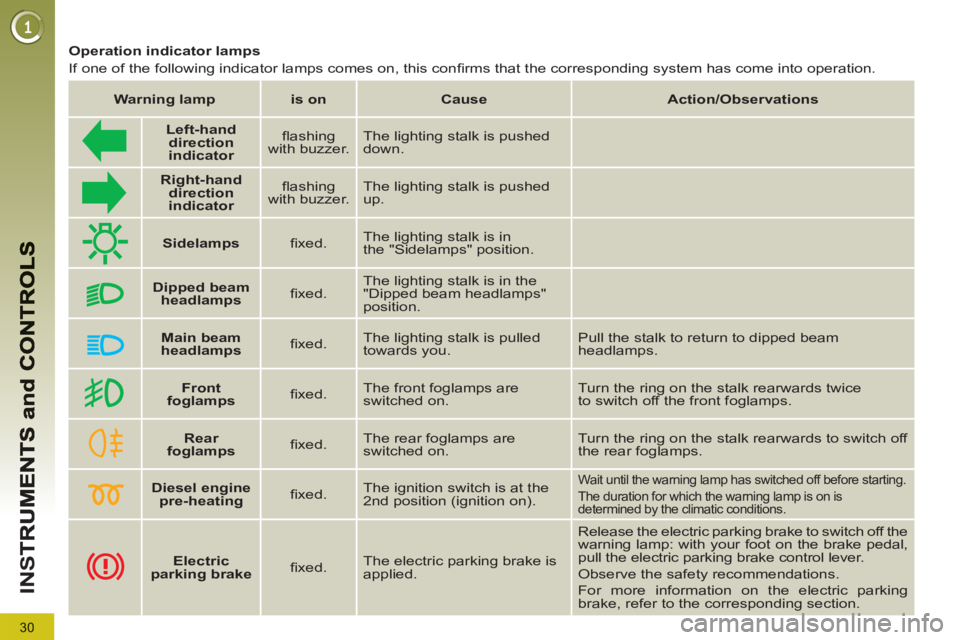
30
IN
S
Diesel engine
pre-heating
fi xed. The ignition switch is at the
2nd position (ignition on). Wait until the warning lamp has switched off before starting.
The duration for which the warning lamp is on is
determined by the climatic conditions.
Left-hand
direction
indicato
r
fl ashing
with buzzer. The lighting stalk is pushed
down.
Right-hand
direction
indicator
fl ashing
with buzzer. The lighting stalk is pushed
up.
Operation indicator lamps
If one of the following indicator lamps comes on, this confi rms that the corresponding system has come into operation.
Warning lamp
is on
Cause
Action/Observations
Sidelamps
fi xed. The lighting stalk is in
the "Sidelamps" position.
Dipped beam
headlamps
fi xed. The lighting stalk is in the
"Dipped beam headlamps"
position.
Main beam
headlamps
fi xed. The lighting stalk is pulled
towards you. Pull the stalk to return to dipped beam
headlamps.
Front
foglamps
fi xed. The front foglamps are
switched on. Turn the ring on the stalk rearwards twice
to switch off the front foglamps.
Rear
foglamps
fi xed.
The rear foglamps are
switched on. Turn the ring on the stalk rearwards to switch off
the rear foglamps.
Electric
parking brake
fi xed. The electric parking brake is
applied. Release the electric parking brake to switch off the
warning lamp: with your foot on the brake pedal,
pull the electric parking brake control lever.
Observe the safety recommendations.
For more information on the electric parking
brake, refer to the corresponding section.
Page 39 of 364
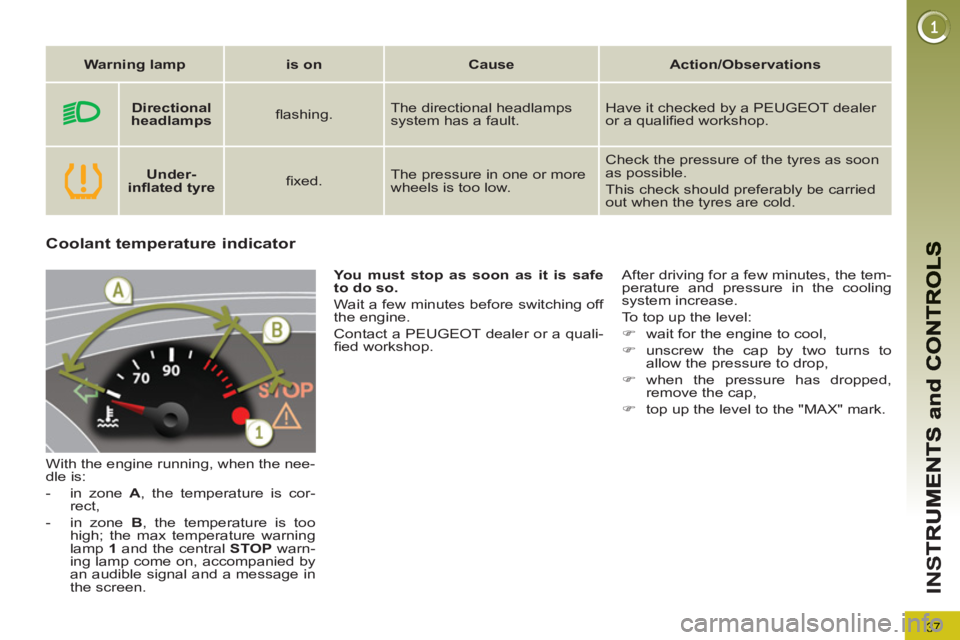
37
IN
S
Coolant temperature indicator
With the engine running, when the nee-
dle is:
- in zone A
, the temperature is cor-
rect,
- in zone B
, the temperature is too
high; the max temperature warning
lamp 1
and the central STOP
warn-
ing lamp come on, accompanied by
an audible signal and a message in
the screen. After driving for a few minutes, the tem-
perature and pressure in the cooling
system increase.
To top up the level:
�)
wait for the engine to cool,
�)
unscrew the cap by two turns to
allow the pressure to drop,
�)
when the pressure has dropped,
remove the cap,
�)
top up the level to the "MAX" mark.
You must stop as soon as it is safe
to do so.
Wait a few minutes before switching off
the engine.
Contact a PEUGEOT dealer or a quali-
fi ed workshop.
Warning lamp
is on
Cause
Action/Observations
Directional
headlamps
fl ashing. The directional headlamps
system has a fault. Have it checked by a PEUGEOT dealer
or a qualifi ed workshop.
Under-
infl ated tyre
fi xed. The pressure in one or more
wheels is too low. Check the pressure of the tyres as soon
as possible.
This check should preferably be carried
out when the tyres are cold.